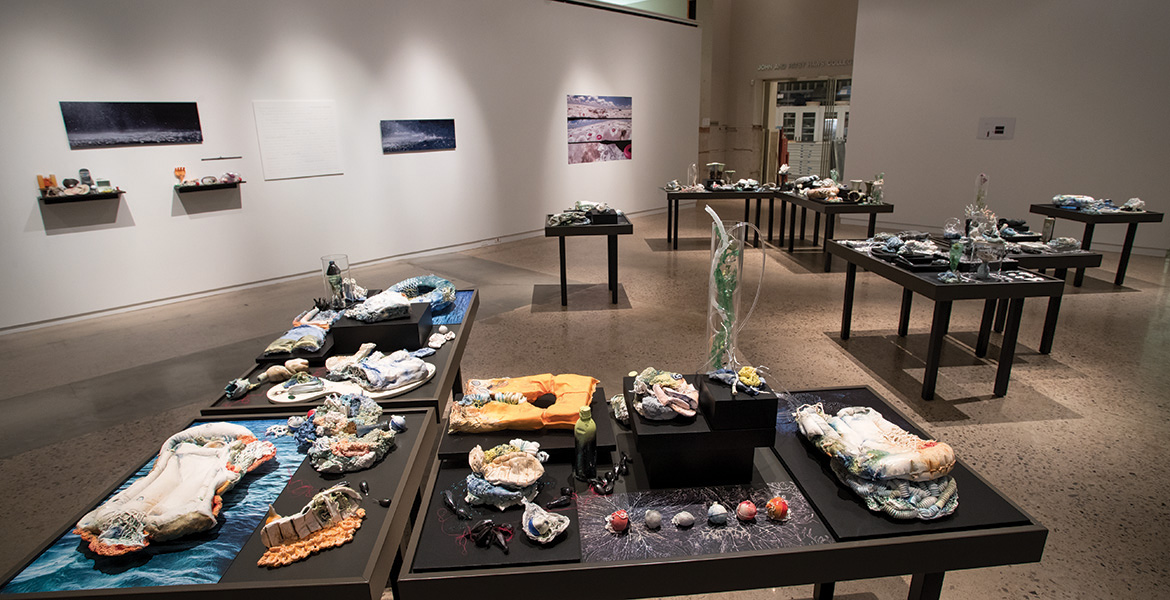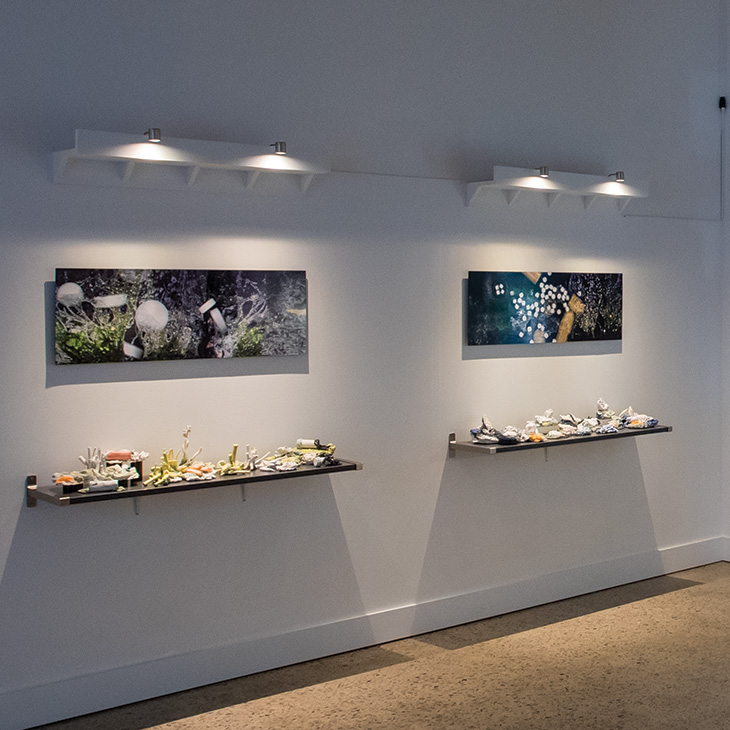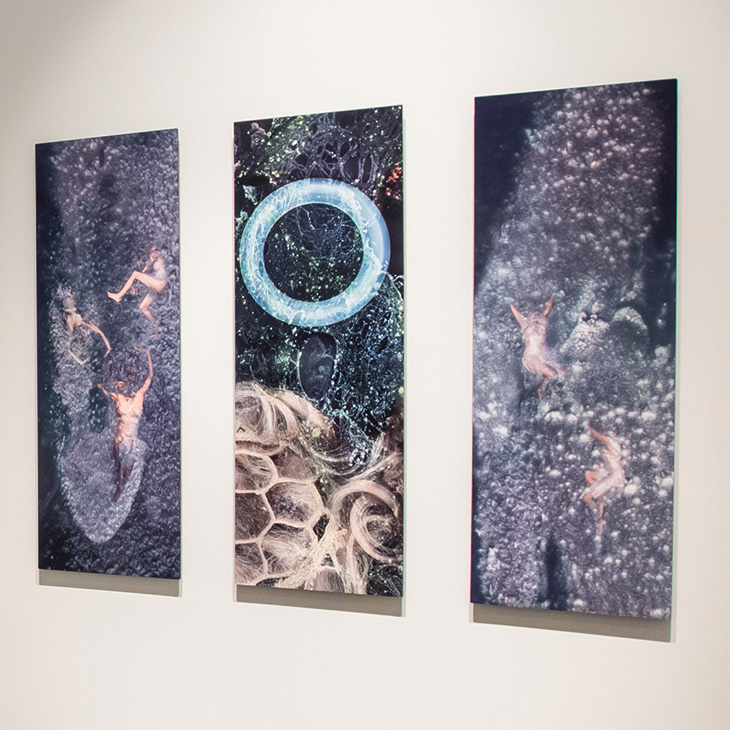
Absorbing Science Via Art
Friday, December 18, 2020
Water.
It’s absolutely vital for life. For science. For art.
The worlds of art and research have now united in a unique new art exhibition at the Oklahoma State University Museum of Art. The exhibition, The State We’re In Water: Constructing a Sense of Place in the Hydrosphere, is designed as a powerful learning platform for science. Including an arts-based research residency and multiple galleries, the exhibition runs through May 29.
Sensory-rich videos, sculptures, and visually complex constructions will activate a visitor’s sense of place and social involvement. The exhibition explores wastewater recycling, watershed habitats and the imprint of water movement on the land. Symptomatic of global issues, the local situations presented are intended to engage the audience in immersive experiences.
“Our goal with this project is to explore how research into the topic of water could be interpreted through the lens of socially engaged artists,” said Victoria Berry, director and chief curator of the OSU Museum of Art. “In arts-based research, projects like The State We’re In Water are built upon the platform of interdisciplina inquiry with many contributors. The choice of subject matter and our successful integration of collaborators have become an important benchmark for future programming. It also helped to receive funding through a grant from the National Endowment for the Arts.”
The artistic team of Robin Lasser, Marguerite Perret and Bruce Scherting worked with the museum for more than four years to accomplish the dynamic interdisciplinary experience.
Lasser is a professor of art at San Jose State University in California who produces photographs, videos, sitespecific installations and public art dealing with environmental issues and social justice. Perret is a professor of art at Washburn University in Kansas whose artwork explores the spaces of art, science, health care and personal experiences.

Scherting is an exhibition designer and the director of Project Art and the Medical Museum at the University ofry Iowa Hospitals and Clinics, managing and maintaining the hospital’s extensive collection of artwork, one of the largest public collections of art in Iowa.
In April 2016, Perret worked with museum staff for a series of interviews recorded at the Student Union and a town hall at the museum. The interviewees list was drawn from a long list of potential candidates and research topics recommended by Dr. Kenneth Sewell, OSU’s vice president for research.
The topics needed to be responsive to the community’s needs and provide a democratic space where the co-construction of ideas by audience and institution is actively pursued. The artists synthesized the information looking for synergies with their already-established socially engaged creative practices.
“The area that we have been working in for the last 20 years is really about biodiversity, conservation, culture, and the intersection of art and science,” Scherting said. “Through that process, we have become very interested in water issues. We have come to realize they are so interlaced. You really need to talk about culture, nature, science and research simultaneously. That is why we are interested in talking to researchers about what they are doing. We find it incredibly fascinating and hopeful as they try to unravel and understand all of those intersections.”
Through numerous trips and a twoweek residency during 2019, Lasser and Perret delved into research. The artists conducted their research with visits to sites that focused on water such as regional lakes and reservoirs, including the Salt Flats, Lake McMurtry, Lake Blackwell, the city of Stillwater Wastewater Treatment Plant and the Port of Catoosa. They connected with OSU scientists in water, environmental science, unmanned systems research, plant biology and many other experts from Stillwater and around the region.
“Taking Marguerite and Robin on our field trips last summer gave my graduate students and the artists an opportunity to learn from each other. The artists could see our research in action as we traveled the state to learn about the challenges we face in protecting our valuable streams and reservoirs in Oklahoma,” said Dr. Scott Stoodley, director of the environmental sciences graduate program at OSU.
From August to December, the artists began translating what they were learning, hearing and seeing into art forms. The resulting exhibition is an assemblage of five distinct installations with each gallery space representing a theme. Each installation aims to immerse viewers in the sensory experiences found in and around water.
“Some of these objects were actually pulled out of lakes in Oklahoma and then cast in porcelain. By collecting and casting and working very experimentally in the porcelain, I have created a collection,” Perret said about the Entangled/Strangled Bank gallery. “Each table tells a slightly different story through the collected objects. The overarching theme is about things shifting and changing — transmutation from a non-human environment to a human environment. The human impact is changing ecosystems, and it is becoming something completely different.”

“If you were to go out to Boomer Lake while it is raining, you look down at the water and you start seeing these ripples interfacing with each other,” Lasser said about the The Weather Report gallery. “You let your mind go at ease for a moment, and you might see what I saw. When the rain struck the water, I saw images that looked like stained glass windows on ancient cathedral walls or very complex patterns. What I began to understand is that nature has always influenced our creative imaginations.”
Their work includes wall text and public artist talks as well as class visits, artist-led art projects and virtual discussions for students. Extending the project over four years provided the opportunity to involve students in the design development. In 2018, Paolo Sanza, an OSU associate professor of architecture, incorporated designing a dynamic boardwalk into his upperlevel architecture class curriculum. After several rounds of student-submitted designs, Sanza and the exhibition artistic team chose a final design for the installation where visitors walk on a boardwalk surrounded by projections of water-related videos and sounds, becoming a part of the spectacle in an immersive experience.
“I like to involve my students in projects like this to gain experience beyond the concept and design phase and into a realized construction,” Sanza said. “It is only through the making and crafting that students can embody construction knowledge and acquire a tactile awareness of their projects. Through this hands-on experience, they also realize the complexity imbued in the making and the poetry of tectonics.”
The exhibition contains an array of experiences and displays.
“The experience of the exhibition is far different than you might anticipate,” said Christina Elliott, associate curator of education. “These works incorporate scientific data on water in graphic design, sculpture, video narrative and kaleidoscopic patterns. The artists bring the viewer into environments created with beautiful, jewelry-like sculptures cast from lakeshore debris. Many elements have titles such as Mystic Sewer Hourglass, Duckweed Detainment Pond, Golden Sewage and Toxic Algae.
“The way that the artists have displayed the different connections that water flows through is very dynamic. They are not only asking us how we develop a relationship with water on an individual level, but they are also asking us to think about water and environmental resources on a local level, state level, national level and even on a global level. No matter where you are or how you interact with environmental conservation, you will find an aspect of this show that is highly relevant to your life.”
The exhibition is available online and in person through May 2021. “This is a wonderful exhibition to bring the whole family to and start little conversations about what is in the water,” said Catarina de Araújo, associate curator of education. “What is your personal impact on the environment and how it can affect other people in the world? We have worked hard to provide art activities that coincide with themes of the show.
“We want to spark conversations and create curiosity.”
